Finding the most versatile player
Recently, Mark Thompson, tweeted out the following question:
Apart from James Milner, who are the most positionally versatile players in football atm?
Many of the responses to the inital tweet are very good, and it’s interesting to see the slightly different interpretations of “positionally versatile” filtered through the lense of player suggestions. If you haven’t already, I suggest you take a look at both the thread and Mark’s newsletter, Get Goalside.
If we take a very simplistic interpretation of “positionally versatile”, the question becomes well-suited to a simple, large-scale search like a database query.
Defining the search
To perform a search like this, we need to ~crudely misinterpret~ hammer out a clear-cut definition for the term “positionally versatile”, as used in Mark’s initial question.
I think it’s reasonable to say that someone who’s versatile can be expected to actually play in a large number of different positions, each requiring multiple skillsets. Therefore, we should be able to find some of the most versatile players by looking at who has played in the most different positions.
Some positions require rather similar skillsets, and so might not count strongly towards any measure of versatility. For example, it is relatively common for players to move between left back and left wing back in different teams or systems. Whereas few players play both as a left back and as a number 10; not everyone can be Marc Mateu.
To get around this, I have re-categorised the playing positions marked by Statsbomb into the following groups:
- Full back (including wing back roles)
- Centre back
- Central defensive midfielder
- Central midfielder
- Central attacking midfielder
- Wide attacker
- Striker
Now, this grouping smooths over all manner of different roles, particularly in central midfield. For example, according to this grouping, both Jorginho and Rani Khedira play in the same position. However, Jorginho is clearly quite a different player from Khedira. In spite of this, I think it’s probably good enough for a first pass, but this is something to bear in mind in case we want to iterate on this idea at a later date.
Another flaw in this method is that we’ll miss out on some players who have the ability play in many different positions, but that haven’t actually been deployed there. I think it would be very interesting to approach the problem from this angle. But in order to do so, I think you’d need a trustworthy model to evaluate each different skill for each player, along with some mapping of skills to playing roles. Whether that model is just sitting on Wyscout for a few ~days~ months, churning through players, or a statistical model, it’s way beyond the time I’m willing to invest for this one blog post. So you’ll have to bear with me and my simple method for now.
Putting all this together, we can look for the most versatile player, being the one who has played in the most distinct position groups, with a minimum of 270 minutes in position. 270 minutes is an entirely arbitrary cutoff. It’s the equivalent of about 3 full matches, which felt about right to me, and the results don’t change too much if you increase or decrease the threshold.
Most versatile players
Using this to count the “versatility” of each player in the top 5 European leagues over the past 3 seasons, we find that the top 3 most versatile players are Weston McKennie, Julian Brandt, and Leonardo Bittencourt. Each of whom has played at least 270 minutes in 6 different position groups:
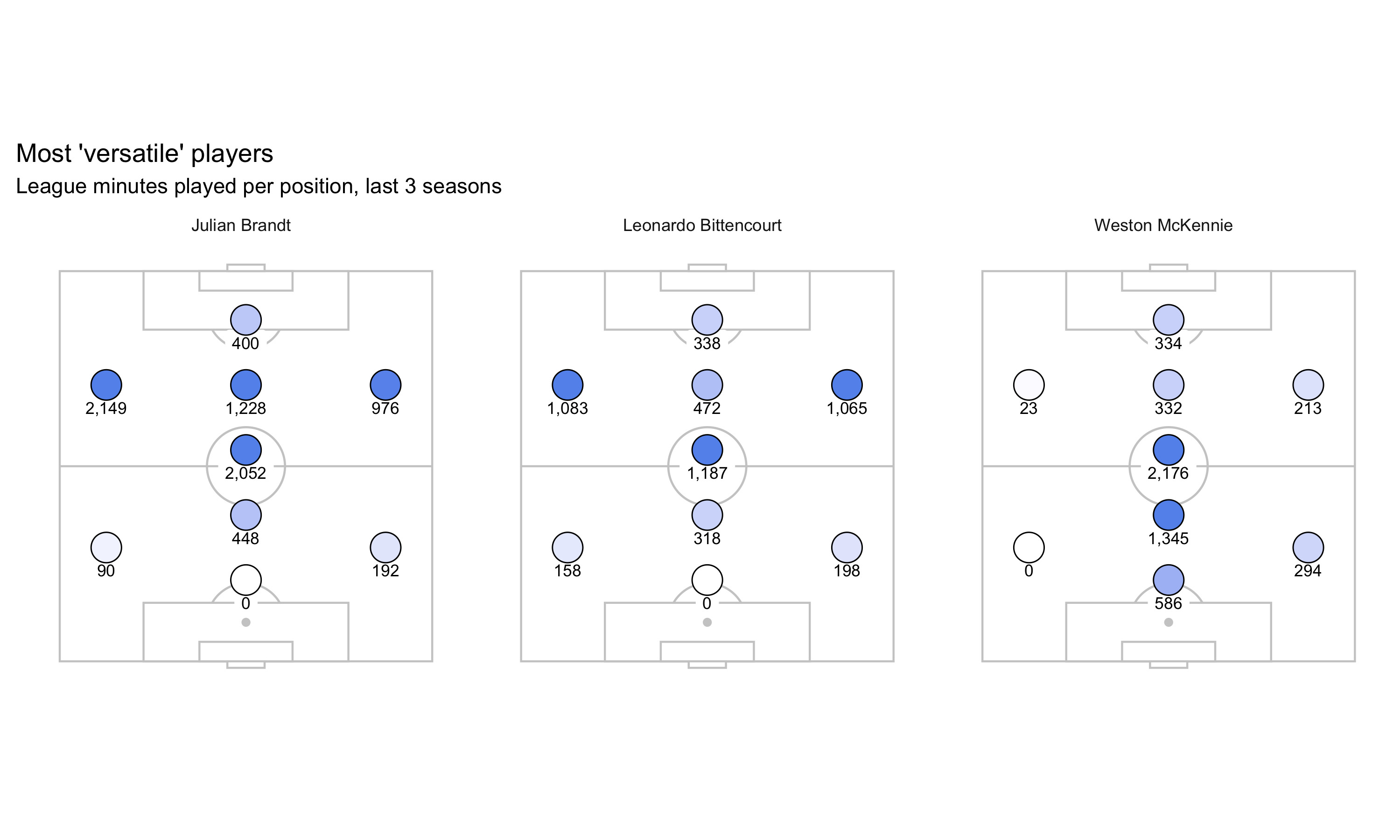
I have to say, out of these 3, McKennie feels like the ‘winner’ in spirit. Brandt’s minutes at wing back counting towards FB feels a little bit generous. And both Brandt and Bittencourt benefit from wide attacking roles being counted separately from central attacking midfield ones, when the required skillset may not actually be all that different, depending on the tactical setup.
Furthermore, McKennie comes very close to meeting our abitrary 270 minutes cutoff in a wide attacking slot (and in fact does, if you include European, cup and international minutes), which would put him into the #1 slot undisputed.
As it happens John Muller got to the same answer just an hour after the original tweet was posted. So, I suppose we never needed all this analysis, after all!
Honourable mentions go to Saúl Ñíguez, who would draw level with these 3 with European and cup minutes included, but narrowly misses out as it is, and Jonny Howson, who wasn’t initially counted because he plays in the Championship:
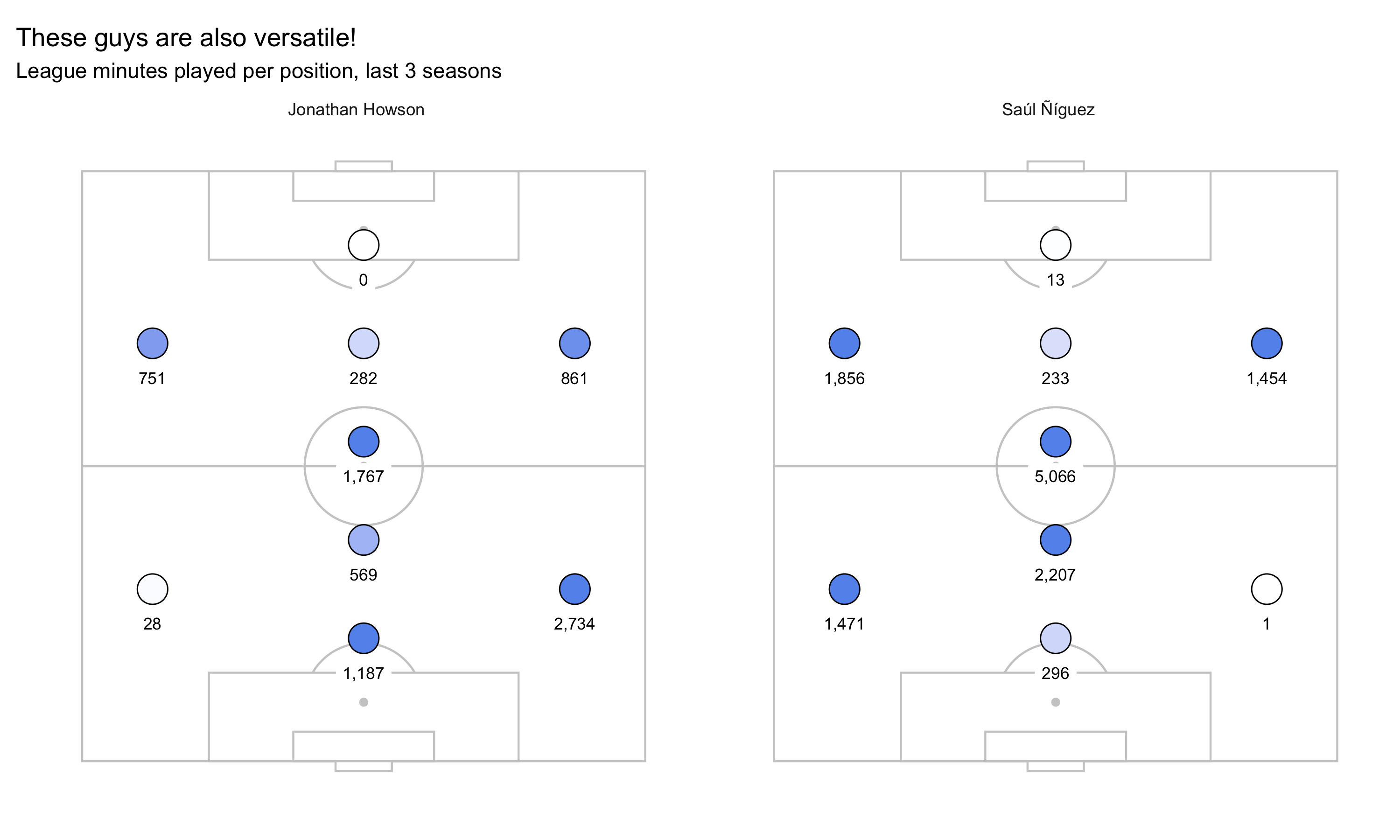
Thanks in part to the lower number of games in the dataset, there aren’t any players from the WSL or NWSL who come out at quite the same level of versatility as McKennie et al; however, Giorgia Stanway and Gunnhildur Yrsa Jónsdóttir both come close:
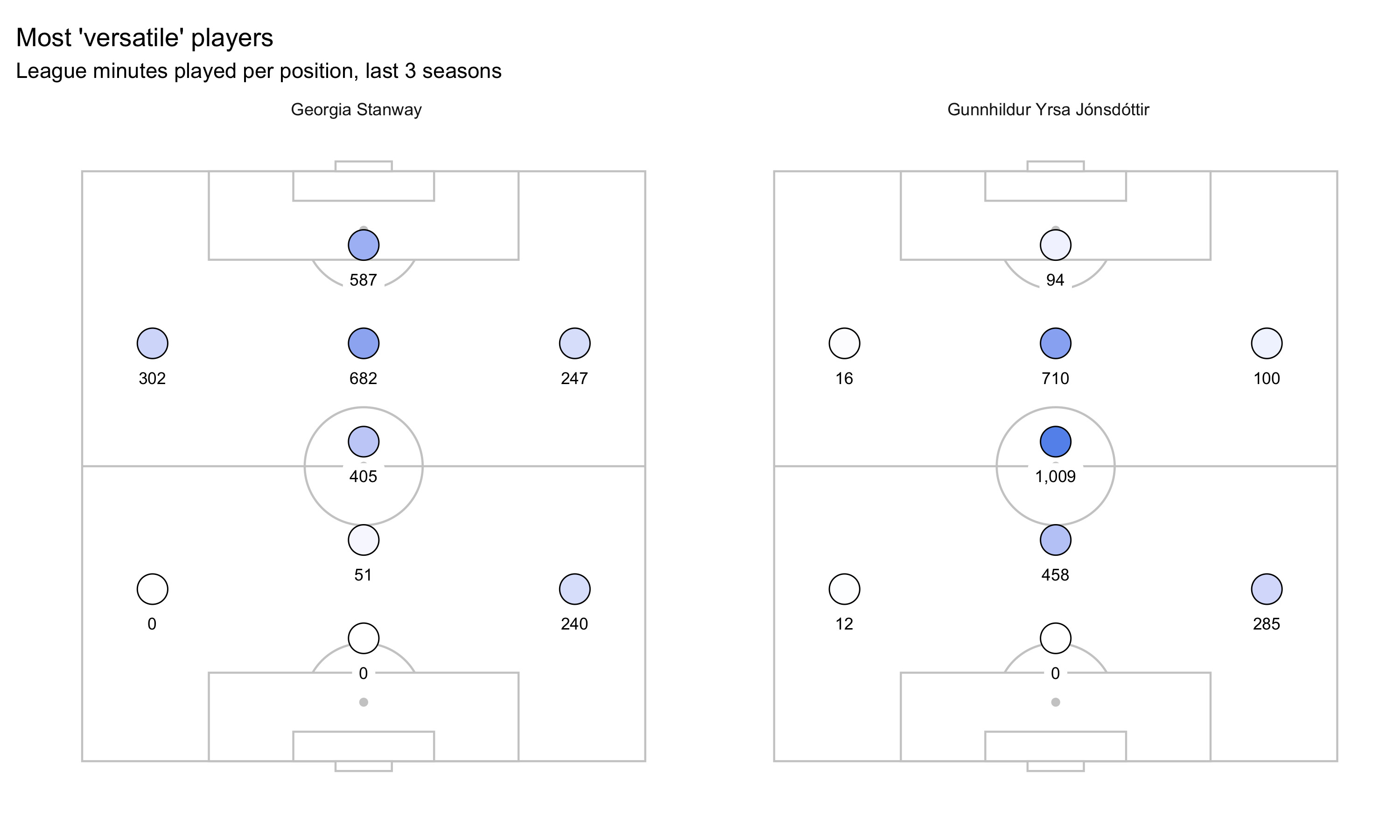
Most versatile… league?
You may have noted already that all of the top 3 most versatile players by the measure we’ve created play in the Bundesliga. Is this a blip or a trend?
The distribution of our versatility measure across the top 5 leagues combined looks like this:
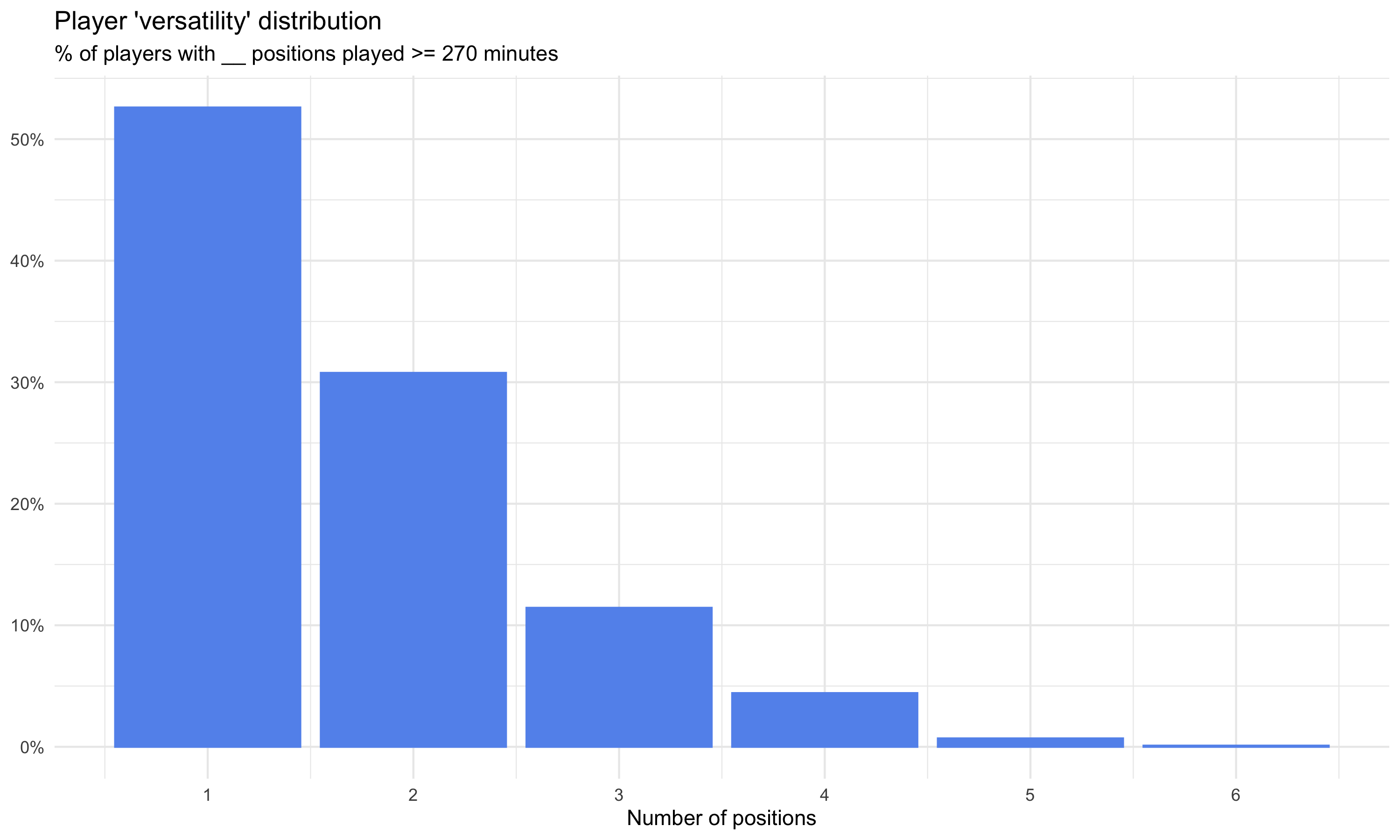
Most outfield players (around 55%) play in only one position group. A reasonable proportion (a bit under 30%) have significant minutes in two position groups, and so on.
Let’s compare the league-specific distributions (gray) to this benchmark (blue):
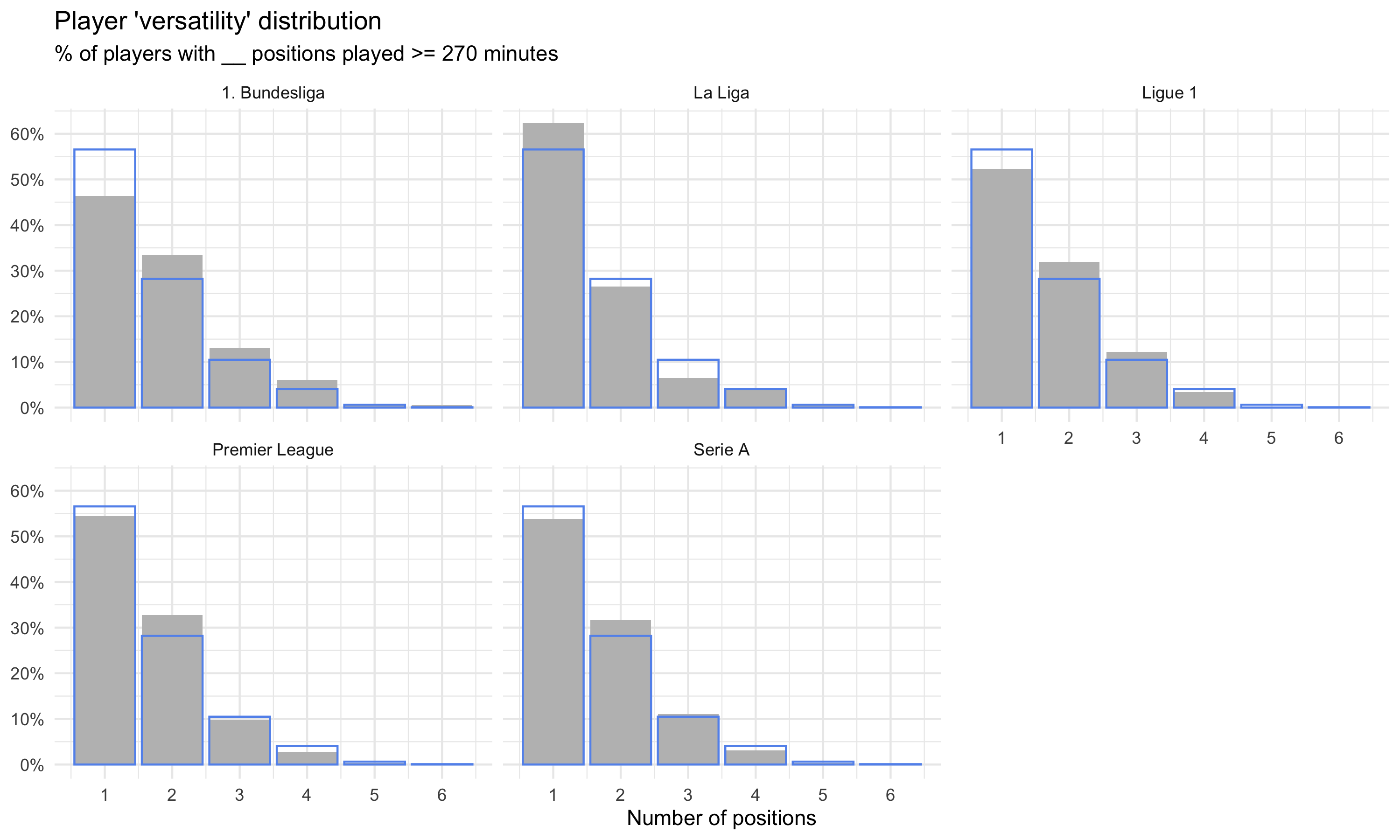
Sure enough, the Bundesliga comes out as the league in which footballers are most likely to be positioned in various different roles. La Liga comes out at the opposite end of the spectrum, with the rest of the Big 5 somewhere in-between.
Is this because Bundesliga players are genuinely more versatile, due to coaching and recruitment practices? Or are the tactics of the league such that the range of required skills is somehow narrower (not in a disparaging way) than in the other leagues?
I would like to go for the coward’s answer of “a bit of both”, but this isn’t a particularly informative answer. So, if pushed, I would lean towards the latter. My hunch is that the tactical inclinations of Bundesliga teams, especially when attempting to win the ball back, allow players with good physical attributes and tactical awareness to fulfil a broader variety of roles without the team’s structure being compromised. In general, this is a nice strategy, as it broadens the pool of players you can effectively bring into the first team. This hunch could be an interesting route for some further investigation and validation.
If you have any thoughts or questions the ideas presented here, please don’t hesitate to reach out.